Detecting Mood Variability at Zero-Acquaintance
Abstract
People make surprisingly accurate judgments about others based on minimal information. At zero-acquaintance, people are able to detect perceptually ambiguous information about others including their personality traits, general affect, and even the presence of a mental disorder (Daros, Ruocco, & Rule, 2016). This study examines whether people are able to detect how much someone’s mood varies from facial appearance. High-affect variability is associated with poorer psychological health along with poorer physical health (Jenkins, Hunter, Richardson, Conner, & Ressman, 2019; Hardy & Segerstrom, 2017). Given that high variability is associated with negative interpersonal consequences, it may be important to detect these qualities at first glance
In Study 1, target participants (N = 200) will have their photograph taken, answer questions about their typical mood, and complete 5 daily diary surveys capturing how much their mood varies across time. In Study 2, perceiver participants (N = 80) will view targets’ facial photographs and indicate the extent to which they think targets’ mood fluctuates. It is predicted that perceivers will be able to accurately detect mood variability at zero-acquaintance. Future research can investigate the cues people use when making such judgments, and how this might influence future social decisions about who to befriend, date, or hire.
Faculty Mentor: Miranda Giacomin
Department: Psychology (Honours)
Published
Issue
Section
License
Authors retain any and all existing copyright to works contributed to these proceedings.



